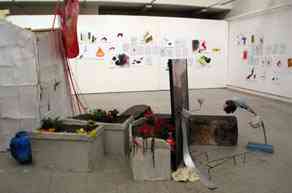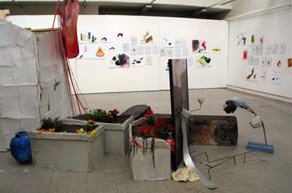Sarah Tritz
Sarah Tritz is an Astérides Resident in 2005, 2006 and 2007. The archives of Triangle-Astérides do not allow for the determination of the exact dates or the duration of this residency in 2005, 2006 and 2007.
Sarah Tritz was born in 1980, she lives and works in Paris (FR)
“Just as an angel, within the bounds of its corporeal circumscription, is composed of all its members, so too is an entire kingdom composed as if the whole were but a single angel,” writes Jacob Böhme in The Aurora. The three-dimensional paintings of Sarah Tritz also take shape through assembled elements whose configuration causes a spatio-temporal emergence involving matter, materials, color, painting, photography, furniture, and a few precisely chosen and handcrafted objects by the artist. Although these propositions are situated within a recognizable contemporary sculptural lineage, alongside Jessica Stockholder, Jason Rhoades, or Franz West, the artist has nonetheless developed genuine autonomy with a singular and complete operational mode. Her field of investigation is grounded in the three dimensions as she might appropriate the interior of a book, using the cover and spine as anchor points on which to brace her tableaux.
The installation then unfolds and opens, like the cardboard figures in a children’s pop-up book. Sarah Tritz paints drawings, floral motifs, takes photographs, makes videos, posters, prints, ceramics, constructs or reproduces abstract, rough, crumpled, figurative or non-concrete forms — always within a specific time frame. “I combine the ephemeral with the precious,” she says. Indeed, each intervention is different, adaptable, transformable. Like Méliès in his day, making a new film for each projection, there remains here too something genuinely creative and handcrafted, something truly ephemeral and precarious, choosing the artistic act based on the thickness of time in which it is managed. There is a clear reference to stage design, if only in the making: if one sees concrete, there will be polystyrene; and if there is a screen, it will float like a curtain.
Blending this fiction between real and fake, between painting and sculpture in this intermediate language, a world is built — a tipping of mental décor, a spatial chimera between dream, transmigration, and apparition. One may find in these constructions the emergence of a psychic landscape, semi-mural or semi-rural, semi-urban or semi-Freudian, a kind of core sampling from a non-existent world, a reconstruction of a dream or a reverie, but one that passes through recognizable forms from our environment. The artist develops a personal lexicon for her work, such as “projector-bomb-quartz” for an anxiety-inducing element, or “abandoned objects” as a tribute to works left behind in her studio. There are also props that are masses, volumes, images, market stand structures, photographs, real paintings, fake paintings, paintings that are photos, photos that are paintings, paper flowers and paper that crumbles like a wall. There are taut lines like Gilberto Zorio’s javelins, light materials that become heavy, serious, burdensome, even unsettling, and others that escape, spread out, settle down, ornament, rise, float.
Here, the installation graphically defines a rocky environment in response to the site. The whole engages with a human dimension, taking the scale of a room that invites a gentle wandering, so that each person, bodily, reframes space and time — like the glazier in a Cocteau film — momentarily becoming part of the sculptural composition of this mental tableau.
— Text by Frédéric Bouglé
Sarah Tritz’ work in on display during the exhibition Abdelkader Benchamma, Sarah Tritz, 2007.

